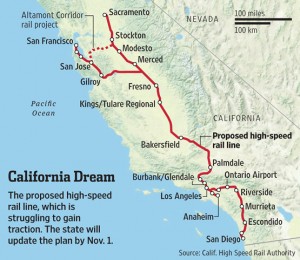Texas, of all places, appears to be beating California in the high speed rail game. As I’ve written before, the proposed line between Dallas and Houston has all the right attributes for success, and it is on track (ahem) with private financing to be up and running by the early 2020s.
Meanwhile, California’s progress is much slower (to be completed sometime in the 2030s at best), while the funding picture grows ever murkier. The financing has recently been undermined by poor cap-and-trade auction proceeds that Governor Brown is using to backstop the lack of available federal and private dollars.
But Texas’ early success could benefit California in key ways. First, it could improve the funding and economics of California’s system. A Texas system could encourage high speed rail manufacturing in the United States. This local production would help California obtain domestically sourced (and possibly cheaper) parts and supplies, which would allow the state to comply more fully with federal funding requirements and therefore secure more such funding.
Texas’ success could also improve the politics for California. Having high speed rail in red state Texas could change congressional attitudes and achieve more bipartisan support for high speed rail in general. That dynamic could lead to more federal dollars for the system, which have been stalled since Republicans took over the House of Representatives.
Finally, Texas’ experience could potentially inspire some improvements to California’s system design. Because California’s is primarily a government-funded system, the route has to satisfy various political constituencies. But with a privately funded system, the Texas train is all about the economics, in terms of speed and service between the most populated areas. As E&E reports (paywall):
And rather than build more than a dozen stations, which would slow California’s line, Texas Central is planning on just three stations: Houston, a central stop roughly halfway between College Station and Huntsville, and Dallas.
Though historically, governments built these systems, Kelly says his company’s private financing model actually gives it the advantage.
“It’s really hard, especially on those long routes, to have fares that are high enough but don’t price everybody out of the market and still pay for the service,” he said. “But even in Amtrak, you find some profitable routes, like the Northeast Corridor.”
Given California’s challenges in attracting federal and private funding to high speed rail, the Texas example may provide important lessons that decision-makers can incorporate. Most prominently, it may involve subtracting some stations in the middle of the route.
At some point, California leaders may need a retrenchment of the system plans to address the financing issue, barring any infusion of federal or private dollars. Who would have thought that Texas may end up as a role model for California’s high speed rail?
One thought on “How High Speed Rail In Texas Could Benefit California”
-
Pingback: Will High-Speed Rail Development In Texas Benefit California? | CleanTechnica
Leave a Reply
You must be logged in to post a comment.



